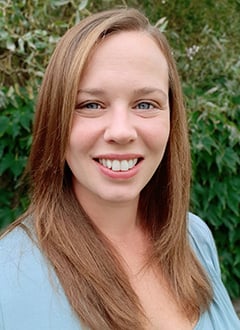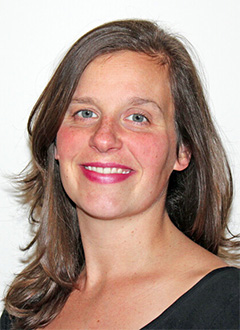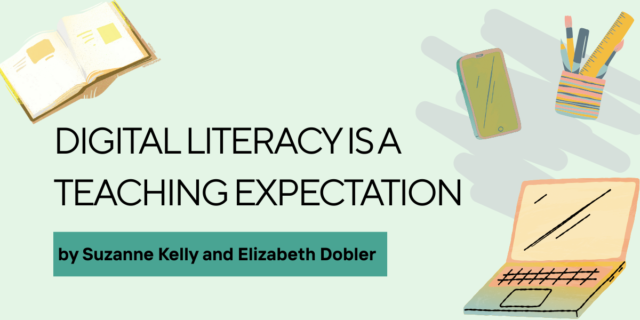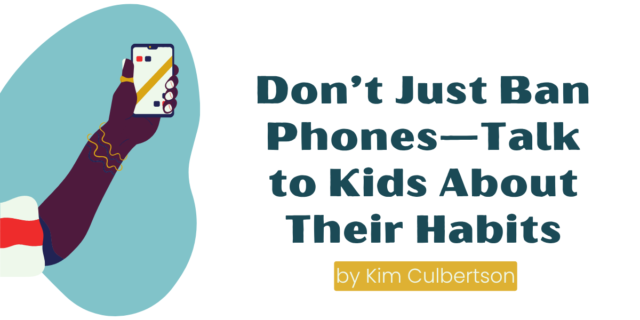
Today on the podcast we’re joined by Sarah Gilmore and Katierose Deos, authors of Integrating Technology: A School-Wide Framework to Enhance Learning. In their book, Sarah and Katierose adopt a holistic and mindful approach to using technology effectively in the classroom. Whether you have iPads for every student, or one computer for the entire class, it is possible to meaningfully integrate technology into your teaching and leadership practices.
Today on the podcast we’re joined by Sarah Gilmore and Katierose Deos, authors of Integrating Technology: A School-Wide Framework to Enhance Learning. In their book, Sarah and Katierose adopt a holistic and mindful approach to using technology effectively in the classroom. Whether you have iPads for every student, or one computer for the entire class, it is possible to meaningfully integrate technology into your teaching and leadership practices.
Our conversation began by asking “what is the role of technology in education?”
Sarah: For us, we really believe that the role of technology in education is to enhance how students learn. It's to make the conditions in the classroom as optimal as possible for learning, and to just break down those barriers that all students face, different kinds of barriers, and to open up opportunities for the way that they learn. So for us it's really about being a tool to enhance student learning in its deepest sense.
Katierose: We also wanted this book to cause people to stop and ask that question of themselves within their school, within their context, because every school is different, working differently. And so the tool that technology can be for learning for your students may look different in your context. But often we were seeing that people, teachers, leaders weren't stopping and asking that question and thinking of it from a holistic standpoint. It was more reactionary, or budgetary or resource filled. And so we felt like something needed to step in and say, "Hold up everybody. Let's think a little bit more about the bigger picture. Let's think about this question."
Brett: I like, Katierose, how you write that you say that this conversation is not just an educational one, it's not just a pedagogy one or a financial one. Why is it important to remind all the different camps about what this conversation is about?
Katierose: I think like many aspects within education, it's complex and schools are complex. Classrooms are complex organisms. And we as teachers, Sarah and I, got tired of seeing the finger pointing. And when we stopped and thought about it, this isn't a conversation that teachers should be having with other teachers. It shouldn't be a conversation that only curriculum leaders are having with teachers. This is a much bigger conversation, because there are so many interdependent parts. In order to make this function in a way that's actually enhancing the learning for the student, we all need to be invested. We all need to be on the same page, moving in the same direction.
Sarah: And I think that what we were seeing a lot in our own experience, and then working with other teachers and leaders and other schools, was that all too often these conversations were happening in isolation.
That teachers were working really hard with other teachers to figure out how can I use the technology in the best way that I can? But then they weren't having the same conversations then with leaders about what can we do at a school level to help me to do that? Or curriculum coordinators not talking to teachers about, what do you need from the curriculum in order to be able to achieve this? And as long as these separate conversations are all happening in separate rooms, we're never going to get to the place where technology can really achieve that potential, because there's always going to be this gap between the idea and the implementation and this lack of joined up thinking.
Brett: So you write about how we need to shift the conversation away from the what of technology and towards the how and why. Can you talk a little bit through about how we do that? How do we shift that conversation?
Katierose: I think it starts with understanding that using technology in the classroom does not look the same for every classroom, for every lesson, for every student. And rather than thinking about what do I need to do this, think about what do I actually want to achieve? What's my core learning for the students? And then planning backwards and seeing does technology even enhance this? Is it worth the student's time and my time using a tool to enhance this? And if not, then okay, move forward. But if yes, then thinking really critically about what it is you want your students to be able to do or achieve or present or share. And then thinking about what tool would be best suited to do that. And then within that we have the core learning that the students need to be able to understand or do. And then you also have the technological skills that they need to be able to use, utilize in order to be successful.
And so then you have two things kind of happening in parallel in that way. Does that make sense? And maybe an example would be best. Would you like an example?
Brett: Sure.
Katierose: Okay. So when we're thinking about technology integration, and let's say we can talk about sequencing with small children. It's a mathematical skill you find in all curriculums. When we're asking, let's say, first, second graders to understand sequencing of events, sequencing of numbers, depending on what you're trying to achieve, you may decide, okay. Let's say technology is really going to enhance what the students are learning. And maybe you want to work with a robot, so that way students can really understand the idea of sequencing. And so you can use something like a Bee Bot, where the students have to program in order to make the robot get to a certain spot in the room or go through a little course.
And in that, your tool that you're using is supporting their understanding of sequencing. Not just learning how to code for code's sake, but it's linked to mathematical thinking as far as understanding the process of sequencing.
Sarah: I'll just jump in there. When we're talking about moving so much from the what towards the how and the why, I think what we're talking about there is the fact that a lot of the stuff that we online, a lot of the professional developments that we as teachers attend, are really focused on the tool. How to use this, the 50 top apps, we're going one-to-one in our district. And here's the technology. And it's very much focused on this kind of physical resource of here's the stuff. But what's really missing is the conversation around why do we have the stuff? What are we going to use it for? What ultimately is our goal in education in having the stuff in the first place? And until we have that conversation where we're moving away from things and towards student purpose, we're never going to be able to use those things in a way that is effective, because we don't really have a purpose. That's the part that we really need to move towards.
Brett: I also like how you write about, early on in the book, about how we need to be doing more to help teachers work with what they have in the classroom. And as you described before about how different schools have different things that are accessible to them. So how can we help teachers work more with what they have already?
Sarah: A big part of that I think with helping teachers is never underestimating the impact that your mindset as a teacher has on your practice with technology. That we all have grown up in a world and experienced things that have given us a mindset or a set of beliefs and ideas about technology that make us feel a certain way with technology. And what that looks like in real life is that some people don't want to use it, or they are frightened of it or they have anxiety about breaking it. A big part of moving us forward in how we use technology is accepting that that is the case and that that is normal, and giving teachers the space to talk about their beliefs and to then move forward into a place where they feel more positive about technology. And providing them with the support both in terms of space to discuss, but also practical support in the classroom and in the school, so that when they are using technology they feel like they have help, they have direction, they know where they're going with the technology.
Brett: I like that you mentioned mindset there. It's a part of the intechgrate model. It's one of the components in the six components that you write about in the framework for technology integration. Can you talk a little bit more about what that intechgrate model is and those six components?
Sarah: The intechgrate model was really the beginning of the whole process for us. That when Katierose and I began to work together in our different roles. And Katierose is the curriculum coordinator and I'm the ed tech person. We realized that we were facing challenges that a lot of teachers were facing and schools were facing in integrating technology. That it seemed like no sooner had we addressed one issue, for example developing the curriculum, then we were fighting another fire. We had a new curriculum but we didn't have the tools to support it. Or the teachers were feeling like they had plenty of resources, but they didn't know what to do with them or they didn't capable of using them. And we were seeing this conversation repeated over and over again in the people that we were talking to. And what we realized was that these weren't a lot of separate different issues that were occurring.
They were symptoms of a larger single issue, which was that technology integration is reliant on a system, a system wide approach. And that if we don't treat it as a system, where curriculum, and mindset, and vision, and purpose, and pedagogy, and leadership and resources all influence one another in this interdependent way, we aren't going to be able to make real progress. Because they're pulling each other back and forward and they're supporting each other and hindering each other. And just addressing one element isn't going to get us anywhere. We have to address all of them at the same time. And that led to the creation of the intechgrate model. And that's why we wrote the book.
Katierose: And to add to that, all of those pieces are interdependent. But at its core, we're talking about student learning. Because oftentimes within these conversations with staff and leaders and tech teams, student learning wasn't the center of the conversation. The resources were, or the curriculum was, or how they felt about screen time was, not student learning. And this is really pivotal within the intechgrate model that we keep our focus on student learning.
Brett: Katierose, how would you like to see people use the book? There's tons of great information in this book, but someone sits down and approaches it. How would you like to have them approach the book?
Katierose: With an open mind. I really think it's important that people who sit down to read this book... Teaching is incredibly personal. And people, teachers get into teaching out of moral purpose, because it's something they feel so strongly about. And technology is one of those pieces that teachers feel strongly about often. And so I want all teachers to approach this book with an open mind, being ready to be a reflective practitioner, being willing to engage in the professional conversation that can happen with the questions that we provide in this book to stimulate thought and to stimulate a school wide conversation about, okay, where are we, what are we doing and how do we move forward?
Brett: Sarah, anything you want to add to that?
Sarah: I thought that was such a good answer. [laughing] I thought I'd just stay quiet.
Brett: All right, let's end with this. You both have a brand new podcast called edYou. On your website it's described as the podcast about bringing education research into the classroom. Tell us a little bit about the new podcast and what you're looking to do with it.
Sarah: We're both geeks. And we wanted an opportunity and an excuse to read research. And we just love to be learning all of the time. And it really started for us because we had questions that we wanted try and answer for ourselves about what is effective teaching, what is the research telling us about best classroom practice, if there even is such a thing. And so it really comes from us from a place of questioning, about wanting to know more about teaching and also about making research as accessible as possible to teachers, because it is not very accessible. It's not affordable, it's not easy to read, it's not even easy to physically access. So for us it's about trying to share our learning with other teachers around the world.
Katierose: And we're really excited about it. We have lots of fun doing it.
Sarah: Gives us a good excuse to chat to each other every day.
Brett: The book comes with an extensive online study guide. What can you tell us about that?
Katierose: Yes, so we have also alongside of writing the book, we have created a resource packet, online resource, to support schools in using this book as a professional development tool to work with staff to develop each of the six factors within the intechgrate model.
Sarah: And we really want, we would love to be able to work with teachers in the real world and work with them on the book. And obviously that's not going to be possible to work with everybody that we would want to work with. So we've really designed that to be asking the questions that we would like to ask in a conversation, and encouraging teachers to have discussions, and write down their thoughts and really bring together that community element. Because the idea behind the intechgrate model, of course, is bringing together all of these different elements in support of student learning. And what that means in real life is bringing together a lot of different people with different areas of expertise to talk about technology integration in support of student learning. And so that's really our goal with this resource. And we hope that people will enjoy it, and use it and access it.
Find Sarah and Katierose's podcast edYou here!
…
 Follow us on Instagram @heinemannpub to stay up to date on the latest books, your favorite authors, and upcoming events!
Follow us on Instagram @heinemannpub to stay up to date on the latest books, your favorite authors, and upcoming events!
 Sarah Gilmore is an EdTech Integration Specialist at Berlin International School in Berlin, Germany. She has taught internationally for many years as an Elementary classroom teacher, before specializing in the use of technology to enhance learning across the curriculum. In addition to her teaching and coaching work, Sarah presents at conferences and workshops internationally.
Sarah Gilmore is an EdTech Integration Specialist at Berlin International School in Berlin, Germany. She has taught internationally for many years as an Elementary classroom teacher, before specializing in the use of technology to enhance learning across the curriculum. In addition to her teaching and coaching work, Sarah presents at conferences and workshops internationally.
She is a co-founder of Intechgrate.eu with Katierose Deos, where she consults with schools and their teachers on integrating technology into wider teaching and learning. You can connect with her on Twitter at @S_J_Gilmore.
 Katierose Deos started her teaching career teaching in K–8 classrooms in the United States. She is currently the Primary Years Curriculum Coordinator at Berlin International School in Berlin, Germany, where she works to implement, develop, and enhance curriculum at both the primary and whole school level. Katierose presents at conferences and workshops internationally.
Katierose Deos started her teaching career teaching in K–8 classrooms in the United States. She is currently the Primary Years Curriculum Coordinator at Berlin International School in Berlin, Germany, where she works to implement, develop, and enhance curriculum at both the primary and whole school level. Katierose presents at conferences and workshops internationally.
She is a co-founder of Intechgrate.eu with Sarah Gilmore, where she consults with schools and their teachers on integrating technology into wider teaching and learning. You can connect with her on Twitter at @DeosKatierose.


